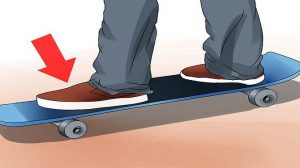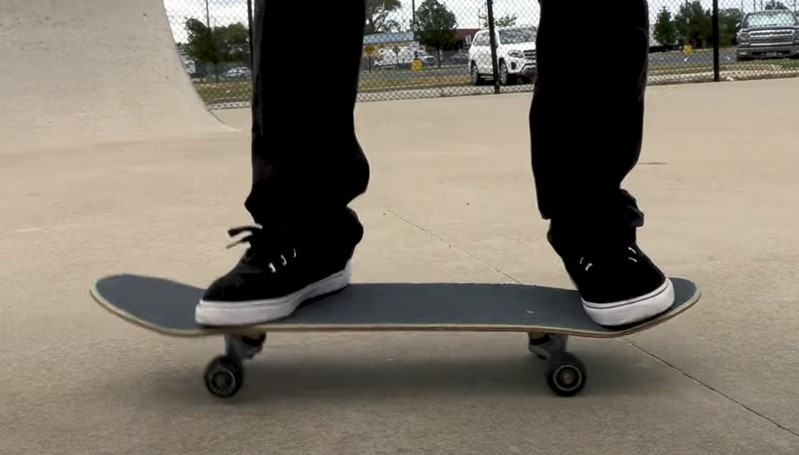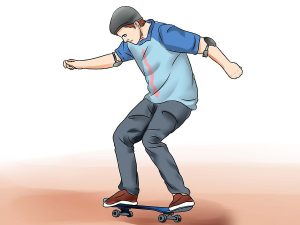In skateboarding, there are two stances to ride aboard: regular and goofy. In the regular stance, a rider straddles the nose of their board with their right foot at the front, left foot at the back. This puts them in control of balancing and turning by shifting their weight onto each foot accordingly.
In a goofy stance, the rider’s opposite foot goes to the front. For example, if a rider has right-footed shoes, they would have their left foot at the front of their board with their right at the back. Goofy is more difficult to ride in because it takes more balance and coordination to maintain your footing while trying to turn or switch directions.
It is common for skateboarders to ride both ways, but most new skaters are encouraged to learn regularly first before slowly trying the other. Professional skateboarder Lance Mountain claims that learning how to ride goofy takes three times longer than a regular stance. It can take up to six months for a beginner on an average of four hours’ practice a day to learn how to ride regularly, but it can take up to a year with twice that practice time.
Learning both together at the same time is difficult because you have to know how to jump on and off your board quickly if they are facing opposite directions. The risk of injury from falling all the time is also higher when practicing both stances.
Some professional skaters, like Tony Hawk and Rodney Mullen, are known for their ability to ride goofy-footed; however, this has not stopped the rest of the world from claiming it as a handicap. Rudy Johnson’s claim to fame is that he never rides regularly.
How to Determine If You Are Regular or Goofy Footed?
The first thing you need to do, if you are trying to find out whether or not you are regular or goofy footed in skateboarding is to determine which foot you place on the board. To do that, simply remove any shoes/socks that cover your feet while standing flat with your feet side by side.
If the outside of your left foot (if you put your right foot on the board) touches the ground, you are regular-footed. If the outside of your right foot (if you put your left foot on the board) touches the ground, then you are goofy-footed.
If neither of your feet touches the ground because they’re hanging in midair and you’re still not sure, then get someone else to help you out.
If you are regularly footed in skateboarding, then this article is not for you. If you are goofy footed in skateboarding, please proceed to the next step (and don’t forget about your ‘twin’).
Step 2: Find out which twin is more dominant
The first part of this step is the trickiest. You need to find out how much influence your non-dominant leg has on your skateboarding, simply by finding out which twin is more likely to end up in front when you’re trying a simple ollie. If one or neither of your feet are behind you or they are the same distance behind you, then neither of them is more dominant. I’m sorry to break it to you, but that’s regular footedness for you.
If your non-dominant leg in front or slightly in front of your other one when both are hanging off the board (and don’t say they’re even because it’ll destroy your self-esteem), then you are goofy-footed. If the same is true for regular footedness, then do not proceed to step 3.
Step 3: Identify which twin is less dominant
If earlier in Step 2 you identified that your non-dominant leg was slightly in front of or exactly behind your other one when both were hanging off the board, then this part is for you.
To begin with, I must tell you that both of your feet are either on the same side or opposite sides of the skateboard. If neither of your legs are touching the ground but one foot is clearly in front of the other, then it’s time to test which twin is dominant by placing your hand on it.
Remember, if the twin’s foot which you use to push is placed in front of the other one (regardless of whether or not there is any weight on it), then that is the more dominant twin. If both legs are placed beside each other with your hand touching one foot and without you having to put any weight on either one, then they are exactly the same.
At this point, you may go back to step 1 if you are regular footed in skateboarding or skip ahead to step 4 for goofy footedness.
Step 4: Combine results from steps 2 and 3 to determine which twin is more dominant
Your skating skills rely heavily on your ability to apply force equally with each leg without the non-dominant twin getting in the way. This step will tell you which of your twins is more dominant by combining both results from steps 2 and 3. All you need to do is subtract the value obtained for step 3 (which was equal or greater than zero) from that obtained for step 2 to get a positive value. If the result is negative, then you should not proceed to the next step (you’re not ready). If the result is positive, then that negative value will tell you which twin your dominant one is. For example; if your non-dominant leg was slightly in front of your dominant one and it was in front of the other when neither were hanging off, then your dominant leg is your non-dominant one. If the opposite was true, then your dominant leg is your dominant one.
If you can’t figure out which twin is more dominant or both are equally (and it’s not 0), don’t even bother trying to skateboard. Just give up now.
If your dominant leg was your non-dominant twin in step 2 and it is your dominant one in step 3, then you are regular-footed. If the opposite is true for both steps, then you are goofy-footed. If the two results from those steps were equal or neither was less than zero, then you are perfectly symmetrical (and I hope that doesn’t make you feel weird).
Related Post:
- Best Skateboarding Camera For Filming & Photography
- Globe Skateboard Review: Are Globe Skateboards Good Brand?
Which styles are better for beginners? Goofy or regular

Goofy has the advantage of being easier to bunny-hop over obstacles because you can use your front foot to launch yourself into the air. Landing regular is harder but once you get used to it, riding regular allows for more technical tricks. Regular also controls speed better than goofy-footed stance at top speeds.
Riding goofy is better for cruising on flat ground because you can more easily turn by shifting your body weight in the direction you want to go. Regular is preferred when executing slides and turns in crowded areas. Goofy is more suitable in half-pipes or bowls where there are no obstacles to worry about, like cars or dogs.
Many people also claim that steering with your back foot is more difficult, but others suggest that it is easier if you have strong ankles.
Overall, riding a regular stance has advantages over goofy, but the choice of which one to use may depend on personal preference. Those who are serious about learning to skateboard will need to practice both stances in order to be fluent in them.
Regular VS Goofy: Skateboarding
How to ride Goofy-footed (Left foot at the front of the board)
1. Place your right foot on the back end of the board with your heel hanging off slightly. Your left foot should be at the front end. If you are wearing longboard shoes, they will have a very loose strap so you can easily slip your feet in and out.
2. Lean slightly to the left (pick one). If you are doing this for the first time it will take a few tries before you get it, so be patient with yourself!
3. Stay low and turn right by leaning on your back foot and pushing down on the front of the board with your front foot.
How to ride Regular-footed (Right foot at the back of the board)
1. Same as above, put your left foot on the front end and right under your body. If you are wearing longboard shoes, they will have a very loose strap so you can easily slip your feet in and out. You should be wearing a helmet for this as well.
2. Keep your weight on the back foot, and lean slightly to the right (again, pick one). If you are doing this for the first time it will take a few tries before you get it, so be patient with yourself!
3. Push down on your front foot and lift up on your back foot to turn left.
How to jump on and off the board?
1. Find a small step or curb, something less than six inches tall that is stable. You want this to be as safe as possible so you don’t fall and get injured. Make sure that it is big enough for your whole foot! If there is no suitable place to practice outside, try following these instructions on the carpet.
2. Place your right foot next to the front of the board so that it is even with the top of the deck, pointing downhill (toward your back). Keep your left foot towards the back end of the board and ready to jump on. You should still be in your regular-footed stance. You may put on your helmet now if you haven’t already.
3. Bend slightly at the knees and jump onto the board with both feet. The back end of the deck should hit your rear foot as you place it down to balance yourself, but you should still be mostly holding on with your front foot.
4. Bend slightly at the knees and jump off of the board with both feet. Remember to keep your weight on your front foot as you step off with it! The back end of the deck should hit your rear foot as you place it down to balance yourself, but again, be mostly holding on with your front foot. Again, practice this a few times on carpet first if necessary.
Conclusion
So, are you a regular or goofy-footed person? Well, if you find yourself kicking up your right leg while walking down the street instead of swinging it to the left and then back again like most people do, congratulations! You’re one in 10 million globally. But don’t worry – there’s no need for any self-deprecating jokes about how “goofy” that makes you. On the contrary; knowing what type of skateboarding style suits you best is an important factor when purchasing new gear (and will prevent many headaches later on). One more thing before we leave this post…did anyone else think it was funny that Google Translate translated ‘regular’ as ‘weird’? Haha!


